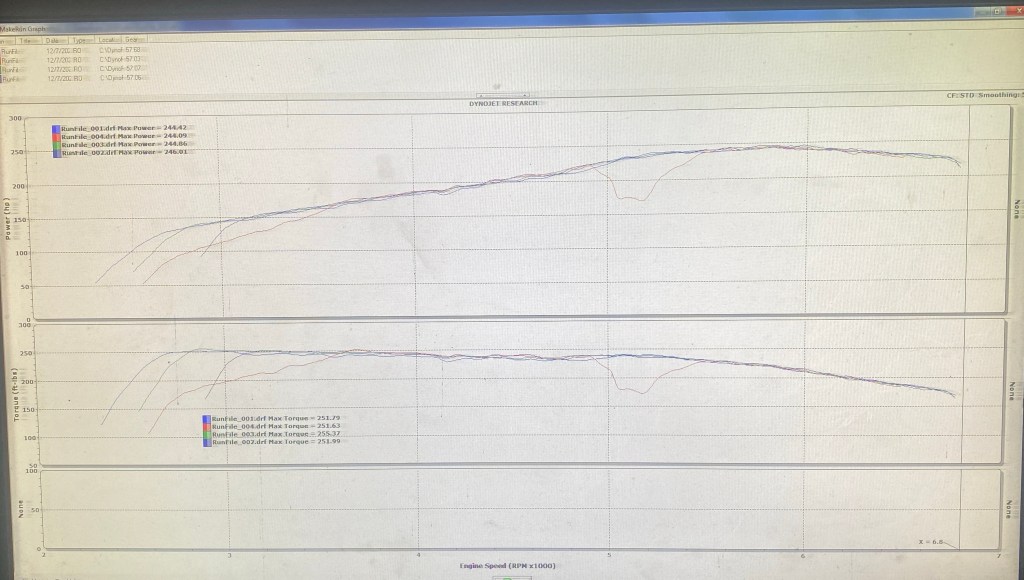The Veloster N has three power levels and three exhaust sound settings, which you can customize to your liking. There is also an economy mode that limits boost pressure and should provide better fuel milage. But how much do these modes differ in power output?

I wanted to know, so I went to Overdrive Automotive in Johnson City and had them dyno my car. (Side note, if you are in Central or Southern NY, I would highly recommend Overdrive for tuning your Megasquirt or whatever, they know Miatas really well.)

I didn’t test all the modes, figuring it was most important to get the data for the lowest and highest power settings.
- Eco: This mode is supposed to limit boost pressure to 6-7 psi and return better fuel milage. I believe this is a separate setting than the lowest engine mode available in N Custom mode, so I selected this mode from the preset modes on the steering wheel button.
- Normal: This is the lowest setting in N Custom mode, and probably the same as choosing Normal mode from the presets. This is the mode I use for all street driving (or when I’m on track and forget to turn on N Custom).
- Sport: I didn’t test the tune in between Normal and Sport+. I didn’t test the middle exhaust setting either.
- Sport+: This is the highest engine setting, which I initially set with the quietest exhaust, because I don’t like pops and bangs or loud pipes.
- Sport+ with exhaust: Same as above, but with the exhaust in the loudest setting. This mode has the burble tune and exhaust valve open, and should show the highest power output.
Note that this test was done on a DynoJet, and so all readings are corrected for elevation and temperature. The engine is bone stock and has about 4000 miles on it (it was replaced once under warranty).
Shockingly, the dyno recorded virtually identical power output in each mode. Even in the green Economy mode, which is supposed to limit boost pressure, the dyno read 244 hp and 251 ft-lbs.

Notice there’s a dip in the chart at one point, the dyno operator said this was likely the ECU pulling timing for a second to deal with heat. The engine was in Eco mode on this pull, but you can see that just a second later the engine picked back up again and posted identical numbers to the other modes.
244 hp is about a 12% drivetrain loss, which is better than I expected. But note that the car was going into winter storage, so I filled the tank with ethanol-free 90 octane, and it may make more power on 93, and even more when the engine loosens up.
What do the engine modes do?
Given that all modes made the same amount of power, the next question is, do the engine modes do anything at all? Knowledgeable people in the N world have stated that the different tunes change the engine’s responsiveness and boost targets in the mid-range, rather than max power. Other sources suggested that the engine modes are only different at partial throttle.
Maybe that’s true, but what about Eco mode? From every account I’ve read, nobody is actually getting better fuel mileage in Eco mode. One source claimed Eco mode only works in the UK. Or that Eco mode is different on different platforms, and limits Velosters to 12-13 psi, but Elantras are limited to 6-7 psi. Well one thing is for certain on my car, either there is no low-boost mode, or all modes are low boost.
Next let’s talk about the tunable exhaust. It did add loudness, but without adding power, I don’t see the point. I like to hear my tires working, it helps me drive at the limit. And so louder pipes just limit my driving.
Finally, there’s the pops and bangs of the burble tune. Internet pundits claim this is to keep the turbo spinning, so that there’s less turbo lag between shifts. I can’t confirm or deny this, as dyno pulls are done in one gear, and so lag (or the lack of lag) doesn’t show up on the dyno. I have a manual transmission, and so I could see this being useful if I missed a shift, but for someone with a 8-speed DCT, I’d question the usefulness of the Rice Krispies soundtrack.
Next year I’ll test the different modes on track and see if I can determine any difference in the data. It may be difficult to ascertain that through the noise of driver error, but we shall see what the Aim Solo data logger says.
At this point, all I can say for sure is that there’s no difference in power or torque in any engine mode or exhaust setting.


